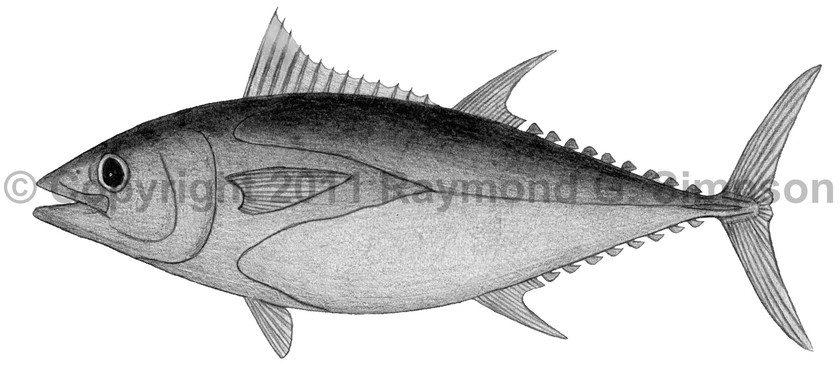
Common Name
Atlantic Bluefin Tuna
Year Described
Linnaeus. 1758
Identification
Dorsal Fin: XIII-XIV, 12-16, followed by 8-10 finlets
Anal Fin: 11-16, followed by 7-9 finlets
Pectoral Fin: 30-36
Gill Rakers: 34-43 (on first arch)
Vertebrae: 39
Body fusiform, robust, and rounded in cross-section. Snout about twice eye diameter. Adipose eyelid absent. Jaw extends to anterior half of orbit. Teeth small and conical. Two interpelvic processes; shorter than pelvic fins. Dorsal fins separated by a very small gap. Spiny dorsal fin long, with a strongly concave margin. Second dorsal and anal fin small with tall anterior lobes. Pectoral fins very short (16.8-21.7% of FL). Caudal fin semilunate. Corselet not obvious but present. Body covered in very small scales. Two small caudal keels with a larger median keel in between them. Liver striated.
Color
Body silvery-gray to white with an abruptly dark blue back. A bluish sheen often apparent. Dorsal fins brown to yellowish-brown. Anal fin and both sets of finlets yellowish. Median caudal keel dark.
Size
Maximum size to over 300cm FL. Common to 200cm FL.
Habitat
Epipelagic and mesopelagic in oceanic waters. Forms schools.
Range
Canada to N. Brazil, including the Gulf of Mexico and the Caribbean Sea.
References
Collette, B.B. 2002. Scombridae (pp 1836-1857). In: Carpenter. 2002. The living marine resources of the Western Central Atlantic. Vol. 3: Bony fishes part 2 (Opistognathidae to Molidae), sea turtles and sea mammals. FAO Species Identification Guides for Fisheries Purposes. American Society of Ichthyologists and Herpetologists Special Publication No. 5.
McEachran, J.D. and J.D. Fechhelm. 2005. Fishes of the Gulf of Mexico. Volume 2: Scorpaeniformes to Tetraodontiformes. University of Texas Press, Austin. i-viii +1-1004.
Other Notes
Records of this species in the southern Atlantic refer to Thunnus maccoyii.